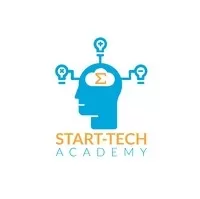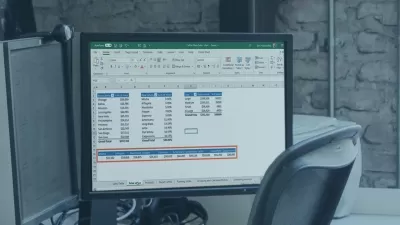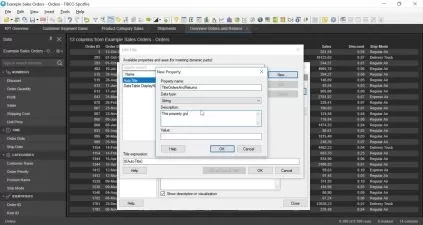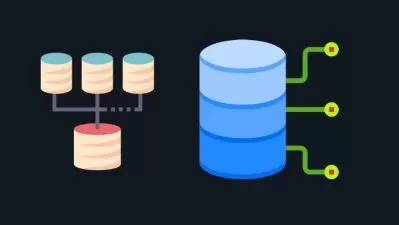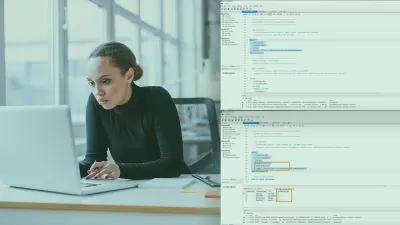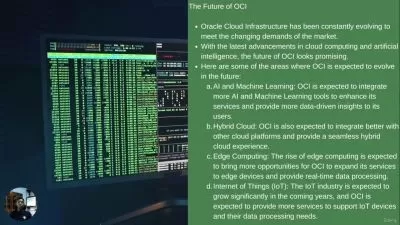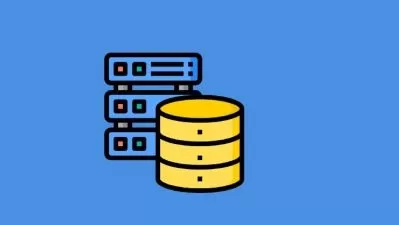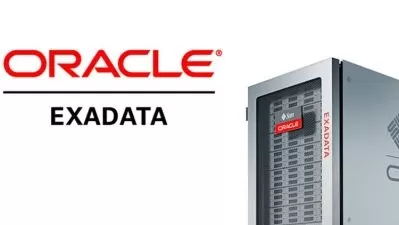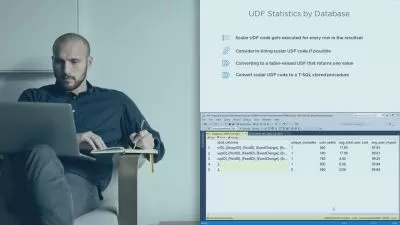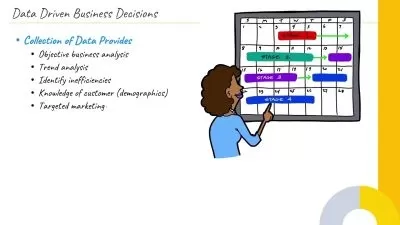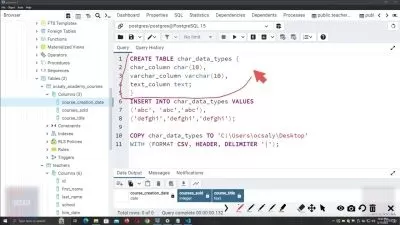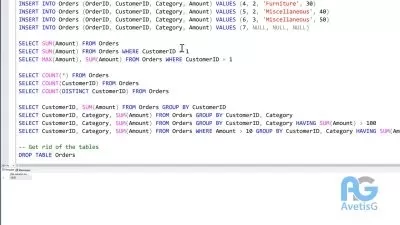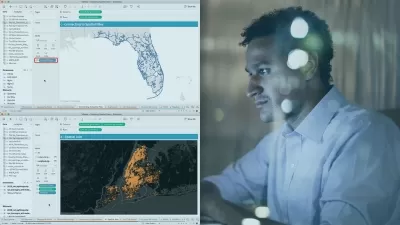Become a Data Scientist: SQL, Tableau, ML & DL [4-in-1]
Start-Tech Academy
36:17:19
Description
4-in-1 Bundle covering the 4 essential topics for a data scientist - SQL, Tableau, Machine & Deep Learning using Python
What You'll Learn?
- Develop a strong foundation in SQL and understand how to use SQL queries to manipulate and retrieve data from a database.
- Explore the features of Tableau and learn to create interactive visualizations to effectively communicate insights to stakeholders.
- Master the concepts of machine learning and learn to implement various machine learning algorithms using Python.
- Discover the basics of Deep Learning and understand how to build and train a deep neural network using Keras and TensorFlow.
- Explore techniques for data preprocessing and feature engineering, including handling missing values and encoding categorical variables
- Master the art of model selection and evaluation, including techniques for cross-validation, hyperparameter tuning, and overfitting prevention.
- Discover the principles of deep neural networks and learn to build and train a convolutional neural network (CNN) for image classification.
- Explore transfer learning and understand how to fine-tune a pre-trained CNN to solve a similar problem in a different domain.
Who is this for?
More details
DescriptionIf you are a curious learner looking to dive into the exciting world of data science, then this course is tailor-made for you! Do you want to master the essential skills required for a successful career in data science? Are you eager to develop expertise in SQL, Tableau, Machine and Deep Learning using Python? If your answer is a resounding "yes," then join us and embark on a journey towards becoming a data scientist!
In this course, you will gain a comprehensive understanding of SQL, Tableau, Machine Learning, and Deep Learning using Python. You will develop the necessary skills to analyze data, visualize insights, build predictive models, and derive actionable business solutions. Here are some key benefits of this course:
Develop mastery in SQL, Tableau, Machine & Deep Learning using Python
Build strong foundations in data analysis, data visualization, and data modeling
Acquire hands-on experience in working with real-world datasets
Gain a deep understanding of the underlying concepts of Machine and Deep Learning
Learn to build and train your own predictive models using Python
Data science is a rapidly growing field, and there is a high demand for skilled professionals who can analyze data and provide valuable insights. By learning SQL, Tableau, Machine & Deep Learning using Python, you can unlock a world of career opportunities in data science, AI, and analytics.
What's covered in this course?
The analysis of data is not the main crux of analytics. It is the interpretation that helps provide insights after the application of analytical techniques that makes analytics such an important discipline. We have used the most popular analytics software tools which are SQL, Tableau and Python. This will aid the students who have no prior coding background to learn and implement Analytics and Machine Learning concepts to actually solve real-world problems of Data Science.
Let me give you a brief overview of the course
Part 1 - SQLÂ for data science
In the first section, i.e. SQL for data analytics, we will be teaching you everything in SQL that you will need for Data analysis in businesses. We will start with basic data operations like creating a table, retrieving data from a table etc. Later on, we will learn advanced topics like subqueries, Joins, data aggregation, and pattern matching.
Part 2 - Data visualization using Tableau
In this section, you will learn how to develop stunning dashboards, visualizations and insights that will allow you to explore, analyze and communicate your data effectively. You will master key Tableau concepts such as data blending, calculations, and mapping. By the end of this part, you will be able to create engaging visualizations that will enable you to make data-driven decisions confidently.
Part 3 - Machine Learning using Python
In this part, we will first give a crash course in python to get you started with this programming language. Then we will learn how to preprocess and prepare data before building a machine learning model. Once the data is ready, we will start building different regression and classification models such as Linear and logistic regression, decision trees, KNN, random forests etc.
Part 4 - Deep Learning using Python
In the last part, you will learn how to make neural networks to find complex patterns in data and make predictive models. We will also learn the concepts behind image recognition models and build a convolutional neural network for this purpose.
Throughout the course, you will work on several activities such as:
Building an SQL database and retrieving relevant data from it
Creating interactive dashboards using Tableau
Implementing various Machine Learning algorithms
Building a Deep Learning model using Keras and TensorFlow
This course is unique because it covers the four essential topics for a data scientist, providing a comprehensive learning experience. You will learn from industry experts who have hands-on experience in data science and have worked with real-world datasets.
What makes us qualified to teach you?
The course is taught by Abhishek (MBA - FMS Delhi, B. Tech - IIT Roorkee) and Pukhraj (MBA - IIM Ahmedabad, B. Tech - IIT Roorkee). As managers in the Global Analytics Consulting firm, we have helped businesses solve their business problems using Analytics and we have used our experience to include the practical aspects of business analytics in this course. We have in-hand experience in Business Analysis.
We are also the creators of some of the most popular online courses - with over 1,200,000 enrollments and thousands of 5-star reviews like these ones:
This is very good, i love the fact the all explanation given can be understood by a layman - Joshua
Thank you Author for this wonderful course. You are the best and this course is worth any price. - Daisy
Our Promise
Teaching our students is our job and we are committed to it. If you have any questions about the course content, practice sheet, or anything related to any topic, you can always post a question in the course or send us a direct message.
Don't miss out on this opportunity to become a data scientist and unlock your full potential! Enroll now and start your journey towards a fulfilling career in data science.
Who this course is for:
- Individuals who want to become data scientists or enhance their skills in data analysis, visualization, and modeling using SQL, Tableau, Machine Learning, and Deep Learning using Python.
- Professionals who want to upskill and add value to their existing roles by learning data science
- Small business owners who want to use data to drive better decision-making in their companies
If you are a curious learner looking to dive into the exciting world of data science, then this course is tailor-made for you! Do you want to master the essential skills required for a successful career in data science? Are you eager to develop expertise in SQL, Tableau, Machine and Deep Learning using Python? If your answer is a resounding "yes," then join us and embark on a journey towards becoming a data scientist!
In this course, you will gain a comprehensive understanding of SQL, Tableau, Machine Learning, and Deep Learning using Python. You will develop the necessary skills to analyze data, visualize insights, build predictive models, and derive actionable business solutions. Here are some key benefits of this course:
Develop mastery in SQL, Tableau, Machine & Deep Learning using Python
Build strong foundations in data analysis, data visualization, and data modeling
Acquire hands-on experience in working with real-world datasets
Gain a deep understanding of the underlying concepts of Machine and Deep Learning
Learn to build and train your own predictive models using Python
Data science is a rapidly growing field, and there is a high demand for skilled professionals who can analyze data and provide valuable insights. By learning SQL, Tableau, Machine & Deep Learning using Python, you can unlock a world of career opportunities in data science, AI, and analytics.
What's covered in this course?
The analysis of data is not the main crux of analytics. It is the interpretation that helps provide insights after the application of analytical techniques that makes analytics such an important discipline. We have used the most popular analytics software tools which are SQL, Tableau and Python. This will aid the students who have no prior coding background to learn and implement Analytics and Machine Learning concepts to actually solve real-world problems of Data Science.
Let me give you a brief overview of the course
Part 1 - SQLÂ for data science
In the first section, i.e. SQL for data analytics, we will be teaching you everything in SQL that you will need for Data analysis in businesses. We will start with basic data operations like creating a table, retrieving data from a table etc. Later on, we will learn advanced topics like subqueries, Joins, data aggregation, and pattern matching.
Part 2 - Data visualization using Tableau
In this section, you will learn how to develop stunning dashboards, visualizations and insights that will allow you to explore, analyze and communicate your data effectively. You will master key Tableau concepts such as data blending, calculations, and mapping. By the end of this part, you will be able to create engaging visualizations that will enable you to make data-driven decisions confidently.
Part 3 - Machine Learning using Python
In this part, we will first give a crash course in python to get you started with this programming language. Then we will learn how to preprocess and prepare data before building a machine learning model. Once the data is ready, we will start building different regression and classification models such as Linear and logistic regression, decision trees, KNN, random forests etc.
Part 4 - Deep Learning using Python
In the last part, you will learn how to make neural networks to find complex patterns in data and make predictive models. We will also learn the concepts behind image recognition models and build a convolutional neural network for this purpose.
Throughout the course, you will work on several activities such as:
Building an SQL database and retrieving relevant data from it
Creating interactive dashboards using Tableau
Implementing various Machine Learning algorithms
Building a Deep Learning model using Keras and TensorFlow
This course is unique because it covers the four essential topics for a data scientist, providing a comprehensive learning experience. You will learn from industry experts who have hands-on experience in data science and have worked with real-world datasets.
What makes us qualified to teach you?
The course is taught by Abhishek (MBA - FMS Delhi, B. Tech - IIT Roorkee) and Pukhraj (MBA - IIM Ahmedabad, B. Tech - IIT Roorkee). As managers in the Global Analytics Consulting firm, we have helped businesses solve their business problems using Analytics and we have used our experience to include the practical aspects of business analytics in this course. We have in-hand experience in Business Analysis.
We are also the creators of some of the most popular online courses - with over 1,200,000 enrollments and thousands of 5-star reviews like these ones:
This is very good, i love the fact the all explanation given can be understood by a layman - Joshua
Thank you Author for this wonderful course. You are the best and this course is worth any price. - Daisy
Our Promise
Teaching our students is our job and we are committed to it. If you have any questions about the course content, practice sheet, or anything related to any topic, you can always post a question in the course or send us a direct message.
Don't miss out on this opportunity to become a data scientist and unlock your full potential! Enroll now and start your journey towards a fulfilling career in data science.
Who this course is for:
- Individuals who want to become data scientists or enhance their skills in data analysis, visualization, and modeling using SQL, Tableau, Machine Learning, and Deep Learning using Python.
- Professionals who want to upskill and add value to their existing roles by learning data science
- Small business owners who want to use data to drive better decision-making in their companies
User Reviews
Rating
Start-Tech Academy
Instructor's Courses
Udemy
View courses Udemy- language english
- Training sessions 303
- duration 36:17:19
- Release Date 2023/06/06





